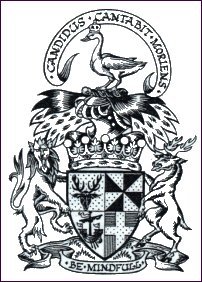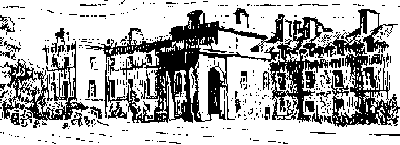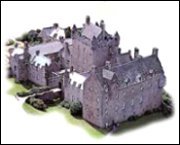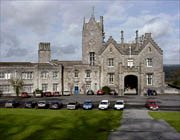LORD CAWDOR OF CASTLEMARTIN
Barony 1796, Earldom 1827
THE CAWDOR COAT OF ARMS. The four quarters of the arms (the shield in the centre) represent, clockwise from left, the Calder, Campbell, Lorne and Lort ancestors. Mottoes: (over crest) Candidus cantabit moriens ('The pure heart shall sing when dying'); (under the arms) 'Be mindful'. Creations: Barony (GB) 21 June 1796. Earl and Viscount (UK) 5 Oct 1827. Until the twentieth century two aristocratic families, the Cawdors and the Dynevors, were the major landowners in south-west Wales. The Cawdors were - and indeed still are - members of the Scottish aristocracy who, unlike the Dynevors, still have their ancestral seat of Cawdor Castle in Nairnshire, Scotland. By embracing the new economy of tourism, one that would have completely mystified their ancestors, this ancient pile still keeps today's aristocratic family in the manner they have been accumstomed to over the centuries. Since 1976 Cawdor castle has even had its own golf course, though at least that sport was a Scottish invention. (Click HERE to see their official website.)
Like the Dynevors, though, the Cawdors have also lost their Welsh possessions, including the two great residences of Stackpole Court in Pembrokeshire and Golden Grove, Carmarthenshire. In the nineteeth century Stackpole Court had been one of the great houses of south Wales, even entertaining the king, Edward the Seventh, in 1902. This illustrious past however couldn't prevent Stackpole Court from being demolished in 1963 and the Cawdor's equally grand Carmarthenshire seat at Golden Grove near Llandeilo survived only by being taken over by the county council in 1951 and run as an agricultural college. In the 1960s when the farmlands of mighty Carreg Cennen castle were sold, the castle was included in the sale by mistake thanks to the slip of a solicitor's pen. Golden Grove and its estate, which was the wealthiest portion of the Cawdor's 100,000 acres, was sold by the 6th Earl of Cawdor in 1972, severing their connections with Wales. The 6th Earl then moved his family to their Scottish stately home of Cawdor Castle, originally built around 1380
The Dynevors, too, saw their ancestral home of Newton House and Dinefwr Castle in Llandeilo pass out of their hands (in 1974) and eventually into the ownership of public bodies. While Golden Grove and Dinefwr Castle still stare at each other from opposite sides of the river Towy in Llandelio, neither of their Lords now reside in their former stately piles.
In 1883 the Cawdors owned 33,782 acres in Carmarthenshire with another 17,735 acres in Pembrokeshire, to which can be added 50,119 acres in their home county of Nairn in Scotland. The total of 101,657 acres brought in an annual income of £44,662 in 1883. (That's equivalent to £2,039,714 a year in today's prices, one pound in 1883 having the purchasing power of £45.67 in Sept 2003, according to Bank of England figures.) In earlier centuries, when Golden Grove was still in the hands of the Vaughan family, the Earls of Carbery, this estate alone had consisted of over 50,000 acres of prime agricultural land.
The Cawdor's former residence of Stackpole Court, Pembrokeshire, where King Edward the Seventh was lavishly entertained in 1902. The building was demolished in 1963 Interestingly, the 51,538 acres in Wales yielded the Cawdors an annual income of £35,042 (£1,600,368 at today's prices) but the 50,119 Scottish acres were worth just £9,620 per annum (£439,345). Their principal residences (note the plural) were Stackpole Court, Pembrokeshire; Golden Grove, Llandeilo; and Cawdor Castle, Nairnshire, Scotland. (Source: 'Complete Peerage', Vicary Gibbs, 1916, which publication also informs us that Earl Cawdor was one of the 28 noblemen who in 1883 owned over 100,000 acres in the UK.)
How the Cawdors, Scottish peers from one of the branches of the Campell clan, came to acquire so much land in Carmarthenshire and Pembrokeshire is a story that comes complete with a legend of its own involving skullduggery and intrigue, at least as related by Herbert M. Vaughan in 'The South Wales Squires', first published in 1926. According to the tale Herbert Vaughan relates below, John Campbell, first Baron Cawdor, used a most devious subterfuge to steal the inheritance to theGolden Grove lands, though given the greater value of the Welsh estates over the Scottish ones, it's perhaps inevitable that he put scruples to one side in order to acquire them.
The most famous of the Cawdors, if Shakespeare's three witches are to be believed, was of course Macbeth ("All hail Macbeth! hail to thee, Thane of Cawdor!"). There was actually a historical Macbeth, born about 1005, but the modern Barony of Cawdor goes back only to 1796, with the Earldom being created in 1827. The modern-day Earls still live in Cawdor Castle, but built as it was in the late fourteenth century, it has nothing to do with Macbeth, historical or Shakespearean.
Following Herbert Vaughan's extract from 'The South Wales Squires' below is the genealogy of the Cawdor peerage, courtesy of 'The Complete Peerage of England, Scotland, Great Britain and the United Kingdom, extant, extinct or dormant' by G.E.C., new edition, revised and much enlarged by the Hon. Vicary Gibbs with the assistance of H. Arthur Doubleday, London, 1916.
THE VAUGHANS AND CAWDORS OF GOLDEN GROVE
From 'The South Wales Squires'
by Herbert M. Vaughan (1870 - 1948)
first published 1926
reprinted with a forward by Byron Rogers
Golden Grove Editions, 1988, pages 69 - 73.
The Cawdor's current, and only residence of Cawdor Castle, near Inverness, Scotland (top) and former residence Golden Grove, Llandeilo, Carmarthenshire (below). More powerful and distinguished than the Pryses of Gogerddan were the Vaughans of Golden Grove, in Carmarthenshire. As the traveller proceeds by rail or road up the fertile and beautiful vale of Towy from Carmarthen, he will note the woods of Golden Grove on his right, and facing them the ancient keep and park of Dynevor. In their day, which may roughly be described as the seventeenth century and the early part of the eighteenth, the Earls of Carbery easily ranked as the first family of South-West Wales; and old Golden Grove gained additional fame from having been the residence of Bishop Jeremy Taylor during the troublous times of the Civil Wars, for he lived quietly here under the powerful protection of Richard Vaughan, second Earl of Carbery and first Baron Vaughan of Emlyn. In Lady Anne Vaughan, his grand-daughter, wife of the first Duke of Bolton, this line became extinct, and the broad estates and fine traditions of Golden Grove passed, by the will of the childless Duchess of Bolton, to her distant relative, Richard Vaughan, then living at Shenfield in Essex. From the son of this Richard Vaughan, Golden Grove passed by will into the possession of the family of Campbell, now Earls Cawdor.
......Amongst the more recent comers into South Wales, the Scottish family of Campbell, later Earls Cawdor, is perhaps the most prominent. This cadet branch of the ducal House of Argyle first became connected with Wales by the marriage of Sir Alexander Campbell of Cawdor Castle, in Nairnshire, with Elizabeth Lort, sister and heiress of Sir Gilbert Lort, last baronet of Stackpole in Pembrokeshire. Their son John Campbell of Cawdor Castle in Scotland and of Stackpole in Wales, married Mary Pryse, one of the co-heiresses of Lewis Pryse of Gogerddan; but since these two alliances there has been no further connexion of the Campbells by marriage with any Welsh family, so far as I am aware. A century or so later the Campbells of Stackpole got a fine windfall under the will of John Vaughan of Golden Grove in Carmarthenshire, who left his estates to his friend John Campbell, afterwards created Baron Cawdor. I have frequently heard it stated that this bequest to one who was no relation in blood came about in this wise. Young Vaughan and young Campbell arranged to make the Grand Tour of the Continent together, and under such circumstances it was customary for the two friends to make wills, each bequeathing the sum total of his possessions to his friend and travelling-companion. This was done in order to prevent delay and seizure of property by foreign officials in the event of one or other of the travellers dying suddenly whilst abroad. Rumour, which is of course only a lying jade, declares that the canny Scot, instead of destroying his friend's will on his return to England, carefully retained the document, and on John Vaughan's death in 1804, apparently intestate, he produced the will that was in his keeping and thereby obtained possession of the valuable Golden Grove estates. Such is rumour; what is the real story I have never heard. Certainly, the last Vaughan of Golden Grove "left a half-sister, Mrs Susannah Watkins, excluded by this will from family property. This was all the more regrettable, as Golden Grove itself had been left expressly by Anne Vaughan, Duchess of Bolton, the last of the line of the former Earls of Carbery, to her distant cousin, Richard Vaughan of Shenfield in Essex, as her nearest male relative in law. And it was Richard's son and heir who thus alienated the ancient Vaughan patrimony.
......Golden Grove is famous in Welsh annals. Its native name of Gelli Aur is probably a corruption of Gelli Oer, the cold grove, for the old mansion lay low down in the valley facing north. Scarcely a trace remains of the ancient home of the Vaughans, Earls of Carbery, for the house has been rebuilt higher up on a new site and in a florid Gothic style suggestive of a Scottish castle. It seems a pity that a place and estate so closely connected with the past history of Wales should have passed, by mere chance, as it were, into another family. This is all the more to be lamented, since Golden Grove possesses the great treasure of the Vaughans, the historic Hirlas Horn, which is popularly believed to have been a direct gift from Henry VII to his host, Dafydd ab leuan of Llwyn Dafydd, on his way to Bosworth Field. From its original possessor this unique relic of the past descended to the Lloyds of Llanlear, whose ultimate heiress, Bridget Lloyd, married Richard Vaughan, Earl of Carbery, since when the Hirlas Horn of the first Tudor king has remained at Golden Grove. There is a fine aquatint of this beautiful piece of plate used as a frontispiece to the first volume of Sir S R Meyrick's edition of Lewys Dwnn's 'Visitations of Wales'.
...... When I was a boy, the political power of the Lords Cawdor stood almost unchallenged in the shires of Pembroke and Carmarthen, wherein they owned immense landed estates. Later it waned considerably, and from being lords-lieutenants of both counties and also members of Parliament, in the present generation its influence has sunk into insignificance, almost nothingness. The fourth earl, before succeeding to the title, contested Pembrokeshire in the Conservative interest some twenty years or so ago; and the paucity of votes he obtained on that occasion must have been both an humiliation and a surprise to a Campbell of Stackpole and Golden Grove: 'lndeed, I felt quite sorry for the young gentleman during the counting of the poll!' said a sympathetic official afterwards."
For those interested in the arcana of genealogy, especially of the peerage, we include below brief biographies of the seven Earls Cawdor of Castlemartin so far (and and seven Viscounts Emlyn, who, as far as can be worked out, are one and the same), plus the name of the heir in waiting. Details of the first four Earls are from 'The Complete Peerage of England, Scotland, Great Britain and the United Kingdom, extant, extinct or dormant' by G.E.C., new edition, revised and much enlarged by the Hon. Vicary Gibbs with the assistance of H. Arthur Doubleday, London, 1916. Our knowledge of the fifth, sixth and seventh Earls is courtesy of 'Burke's Peerage and Baronetage' (1999).
CAWDOR OF CASTLEMARTIN
BARONY 1796, EALRDOM 18271ST BARON CAWDOR OF CASTLEMARTIN. Title created in 1796
JOHN CAMPBELL, son and heir of Pryse C., of Stackpole Court, County Pembroke, by Sarah, daughter and coh. of Sir Edmund BACON, Bart., which Pryse C. was son and heir apparent of John Campbell, of Cawdor Castle, (note 1 below) County Nairn (who died 6 Sep. 1777), but died v.p.; was born about 1753; M.P. (Tory) for County Nairn, 1777-80; (note 2) for Cardigan, 1780-96. F.S.A. 19 June 1794; F.R.S. 4 June 1795. On 21 June 1796 he was created BARON CAWDOR OF CASTLEMARTIN. County Pembroke. Colonel in the army, during service, 1799; D.C.L. Oxford, 3 July 1810. He married, 28 July 1789, at her father's house, in Grosvenor Place, Isabella Caroline, 1st daughter of Frederick (HOWARD), 5th EARL OF CARLISLE, by Margaret Caroline, daughter of Granville (LEVESON-GOWER), 1st MARQUESS OF STAFFORD. He died in Great Pulteney Street, Bath, I, and was buried 9 June 1821, aged 66, in Bath Abbey (note 3). M.I. His widow, who was born 3 Sep. 1771, died 8 Mar. 1848, at Twickenham, aged 76. Will pr. Apr. 1848.2ND BARON (succeeded 1821), 1ST VISCOUNT EMLYN OF EMLYN (created 1827) and 1ST EARL CAWDOR OF CASTLEMARTIN (created1827)
2 and 1. JOHN FREDERICK (CAMPBELL), BARON CAWDOR OF CASTLEMARTIN, son and heir, born 8 Nov. and baptised 9 Dec. 1790, in London; matriculated at Oxford (Christ's Church) 21 Oct. 1808, B.A. 1812 (2nd class classics). M.P. (Whig) for Carmarthen, 1813-21. (note 4) On 5 Oct. 1827 he was created VISCOUNT EMLYN of Emlyn, County Carmarthen, and EARL CAWDOR OF CASTLEMARTIN, County Pembroke. Was Bearer of the Queen's ivory rod at the Coronation, 8 Sep. 1831. Harleian Trustee of the Brit. Museum 1834 till his death. Hon. D.C.L. (Oxford) 15 June 1841. Lord Lieut. of County Carmarthen 1852 till his death. He married, 5 Sep. 1816, in Grosvenor Sq. (special licence), Elizabeth, 1st daughter of Thomas (THYNNE), 2nd MARQUESS OF BATH, by Isabella Elizabeth, daughter of George (RING), 4th VISCOUNT TORRINGTON. He died 7 Nov. 1860, at Stackpole, and was buried there, aged 70 all but a day. Will pr. 10 Apr. 1861, under £120,000. His widow, who was born 27 Feb. 1795, died 16 Feb. 1866, at 3 Tilney Street, Park Lane, Midx., aged nearly 71. Will pr. 5 Mar. 1866, under £3,000.2ND EARL CAWDOR (succeeded 1860)
2 and 3. JOHN FREDERICK VAUGHAN (CAMPBELL), EARL CAWDOR OF CASTLEMARTIN, &c, son and heir, born 11 July 1817, in Grosvenor Sq., Midx.; ed. at Eton; matriculated at Oxford (Christ's Church), as Viscount Emlyn, 27 Jan. 1835, B.A. 1838, M.A. 1840. M.P. (Conservative) for County Pembroke, 1841-60. Private Sec. to the Lord Privy Seal, 1841-42. Lord Lieut. of County Carmarthen 1861 till his death. He married, 28 June 1842, in St. George's, Hanover Square,(note 5) Sarah Mary, 2nd daughter of General the Hon. Henry Frederick Compton CAVENDISH, by his 1st wife Sarah, daughter of William AuGustus FAWKENER. She, who was born 27 August 1813, at Sutton Court, Chiswick, and who was Maid of Honour to the Queen, 1837-42 (note 6) died 21 Apr. 1881, at Stackpole Court, aged 67, buried there 2 April 1898, in his 81st year. Will dated 9 Aug. 1894, pr. 14 June 1898.3RD EARL CAWDOR (succeeded 1898)
3 and 4. FREDERICK ARCHIBALD VAUGHAN (CAMPBELL), EARL CAWDOR OF CASTLEMARTIN (1827), VISCOUNT EMLYN (1827) and BARON CAWDOR OF CASTLEMARTIN (1796), son and heir, born13 Feb. 1847, at St. Leonard's Hill, Windsor; educated at Eton, and at Christ's Church Oxford. M.P. (Conservative) for County Carmarthen, 1874-85. Ecclesiastical Commissioner, 1880 till his death. Commissioner of Lunacy 1886-93; Chairman of the Great Western Railway 1895-1905; Lord Lieut. of County Pembroke 1896 till his death; Militia A.D.C. to Queen Victoria 1899-1901, and to Edward VII, and George V, 1901 till his death; President of the Royal Agricultural Society 1901; P.C. 14 Mar. 1905; FIRST LORD OF TUE ADMIRALTY Mar. to Dec. 1905.(note 7) He married 16 Sep. 1868, at Stoke Rochford, County Lincoln, Edith Georgiana, 1st daughter of Christopher TURNOR, of Stoke Rochford aforesaid, by Caroline, daughter Of George William (FINCH-HATTON), 9th EARL of WINCHILSEA. He died in a nursing home in London, from the effects of a chill, 8, and was buried 11 Feb. 1911, at Cheriton, County Pembroke, aged nearly 64 (note 8). Will dated 7 Sep. 1903, pr. 25 Apr. 1911, gross £,633,328, net £52,973. His widow was living 1913.4TH EARL CAWDOR (succeeded 1911)
HUGH FREDERICK VAUGHAN CAMPBELL, styled VISCOUNT EMLYN (1898-1911), 1st son and heir apparent, born 21 June 1870; educated at Eton; matriculated at Oxford (Christ's Church) 1889, B.A. 1893. He married 11 June 1898, at Westrninster Abbey, Joan Emily Mary, 1st daughter of John Charles THYNNE, by Mary Elizabeth, younger daughter of Sir John Atholl Murray MACGREGOR, 3rd Bart. She was born 30 Oct. 1872, at 3 The Cloisters, Westminster Abbey.5TH EARL CAWDOR (succeeded 1914)
JOHN DUNCAN VAUGHAN CAMPBELL (1900-1970). He married, firstly, Wilma Mairi Vickers, daughter of Vincent C. Vickers, on 15 May 1929. They had three children: Caroline Mairi Campbell (b. 10 May 1930); Hugh John Vaughan Campbell, 6th Earl Cawdor (1932-1993); James Alexander Campbell (b. 21 July 1942). He married, secondly, Elizabeth Topham Richardson, daughter of John Topham Richardson, on 29 June 1961.6TH EARL CAWDOR (succeeded 1970)
HUGH JOHN VAUGHAN CAMPBELL, (1932-1993). Born 6th September 1931, died 20th June 1993. He married, firstly, Cathryn Hinde, daughter of Maj.-Gen. Hon. Sir William Robert Norris Hinde and Evelyn Muriel Wright, on 19 January 1956. They had five children. He divorced his first wife to marry secondly on 28 December 1979 Angelica Ilona Lazansky von Bukowa (b. 22 February 1939), the daughter of Czech aristocratic parents who was raised in Rhodesia. The second Countess is said to be the daughter of Count Prokop Lazansky von Bukowa, or the daughter of this man or a namesake. By the terms of her husband's will, she and not her stepson inherited Cawdor castle in North Scotland.7TH EARL CAWDOR (SUCCEDED 1993)
COLIN ROBERT VAUGHAN CAMPBELL, born 30th June 1962, son of the 6th Earl and his 1st wife, Catheryn, daughter of Major-General Sir Robert Hynde, KBE, CB, DSO. Succeeded father 1993. Married 1994 Lady Isabella Stanhope, youngest daughter of Earl of Harrington. Educated Eton, St Peter's College, Oxford. Member James Bridal Memorial Scociety, London. The Heir Apparent is the present holder's son, James Chester Campbell, Viscount Emlyn (b. 1998).FAMILY ESTATES
These, in 1833, consisted of 33,752 acres in County Carmarthen, 17,735 in County Pembroke, and 21 in County Cardigan, viz. 51,538 acres in Wales, worth £35,042 a year; besides 46,176 acres in County Nairn and 3,943 in County Inverness, viz. 50,119 acres in Scotland, worth £9,620 a year. Total, 101,657acres, worth £44,662 a year. Principal Residences- Stackpole Court, County Pembroke; Golden Grove, County Carmarthen; and Cawdor Castle, County Nairn. (note 9)NOTES TO ABOVE
(The following notes accompanied the entry in 'The Complete Peerage etc' mentioned above.)(1) Muriel, daughter and heir of Sir John Calder, of Calder or Cawdor, County Nairn, married, in 1510, Sir John Campbell, 3rd son of Archibald, 2nd Earl of Argyll [S.], bringing this and other Scottish estates to the Campbell family. Elizabeth, sister and heir of Sir Gilbert Lort, Bart., of Stackpole Court, married 1689, Sir Alexander Campbell, of Cawdor, a descendant of the above, and their son and heir, John Campbell, married in 1726, Mary, daughter and coh. of Lewis Pryse, of Gogarthan, being parents of Pryse Campbell, the father of the 1st Baron Cawdor.
(2) He was a staunch supporter of Lord North both before and after he coalesced with Fox. He voted with the Whigs against Pitt's Regency Bill, but came over to him with Portland and Burke in 1794, and supported his war policy, being accordingly rewarded with a Peerage. After 1802 he followed the Grenvilles, was a strong pro-Catholic, and from about that time onward must again be classed as a Whig. J. H. Round points out that his chief distinction was the capture of the French force which landed in Fishguard Bay 22-24 Feb. 1797, and surrendered, without fighting, to him, when in command of the local troops.
(3) "One of the most amiable and unselfish men that ever existed." (Henry Greville's Diary, 10 Nov. 1860).
(4) He was originally a Whig, but joined the Conservative party after the Reform Bill of 1832 (for which he voted), changing like his father, but in the opposite direction. He was one of the 89 Protectionist peers who signed the protest against the Repeal of the Corn Laws in 1846.
(5) This was a double wedding, his sister Elizabeth being married at the same place and time to John (Cuffe), 3rd Earl of Desart.
(6) "Your Majesty having generally chosen handsome and attractive girls for the Maids of Honour, which is very right, must expect to lose them in this way. Lord Melbourne is very glad of the marriage. Lord Emlyn always seemed to him a very pleasing young man, and well calculated to make a woman happy." (Viscount Melbourne: letter to Queen Victoria, 15 May 1842).
(7) His appointment to the highly important post of First Lord of the Admiralty occasioned some surprise, as he had never held office before: the way in which he administered the department, however, fully justified his selection.
(8) He was a most efficient chairman of the Great Western Railway; arid was one of the numerous peers who have been directors of public companies.
(9) Earl Cawdor is one (the smallest owner) of the 28 noblemen who in 1883 possessed over 100,000 acres in the United Kingdom.
Further Information:
Stackpole Court (includes the medieval and modern history)
Golden Grove by Carmarthenshire County Council
Golden Grove by Cambria Archeaology




